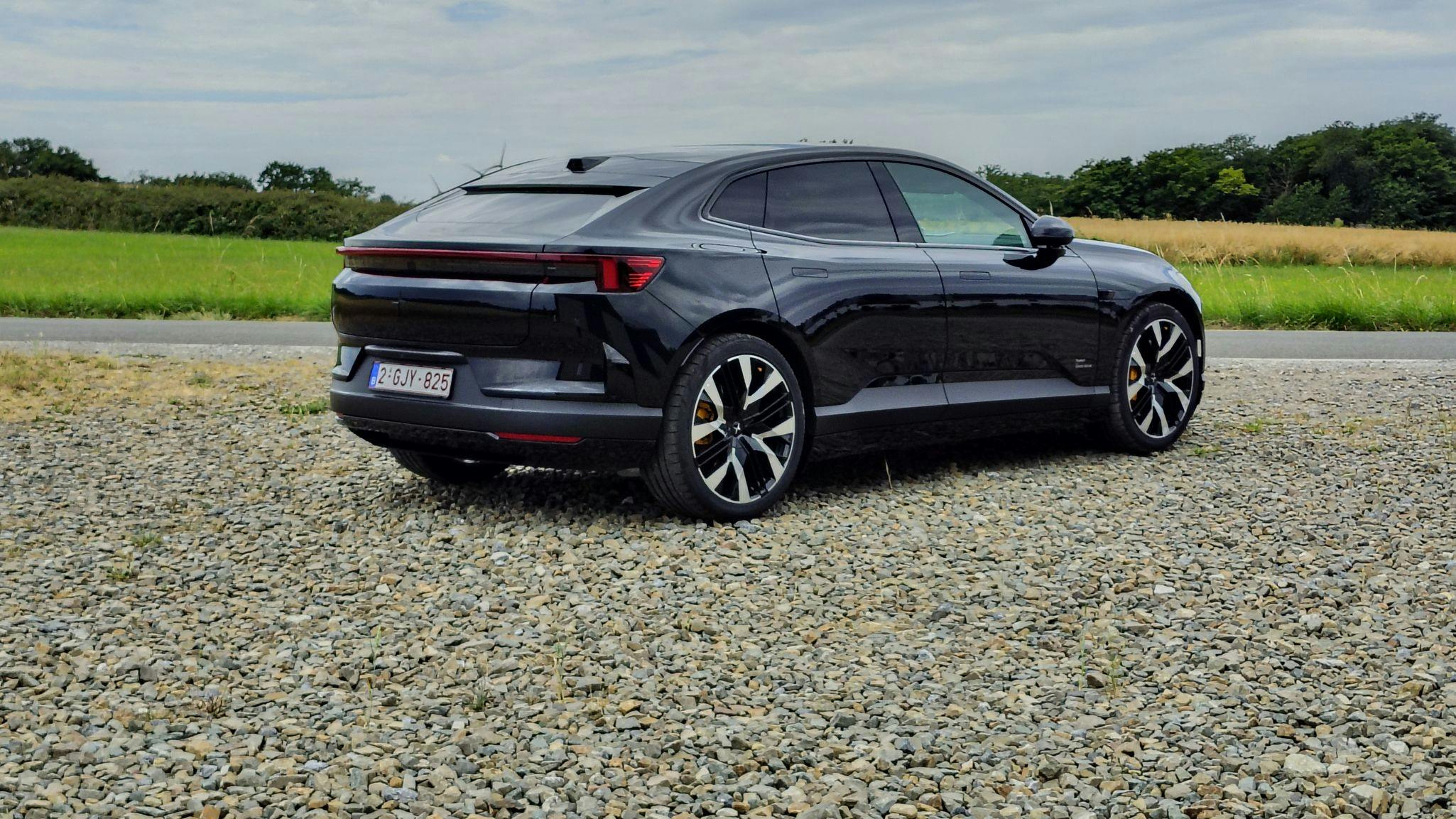
TAGTIK NEWS - TO THE POINT
Polestar 4: Swedish Flair and Chinese Engineering

Polestar is a Sino-Swedish brand from the Geely galaxy, but based in Gothenburg, Sweden. This makes sense, given its ties to its cousin Volvo, which belongs to the same Hangzhou-based automotive group. The 4 is arguably the current model that most embodies Polestar's ambitions.

At Polestar, the number after the brand name has nothing to do with any classification of range or size. It's simply the order of arrival in the catalog. So, the 3 is larger than the 4, for example. It's precisely the 4 that we tested. The one with the two motors, all-wheel drive, and the large battery. The Polestar 4 Long Range Dual Motor has 544 hp (400 kW) and 686 Nm of torque. It's no surprise, then, to discover that 0 to 100 km/h takes barely 3.8 s. An acceleration that makes the smartphone fly off its induction charging stand, not tilted enough to compensate for inertia. Here it is in the cup holder now. At least it proves that when you put the pedal to the metal, the sensations are powerful with its lightning-fast acceleration. But you don't have to be that extreme with your right foot.

Imperial
In China, customers pay close attention to rear passenger space. In this regard, the Polestar 4 doesn't deny its origins, despite its Swedish design. The cabin of this crossover is very welcoming. Everything is perfectly assembled with high-quality, eco-conscious materials. They are pleasant to the touch, without excessive frills. The storage compartments are scattered throughout the cockpit. Rear passengers can adjust their temperature and even manage their playlists via a small screen between the seats. Moreover, the seats are comfortable, adaptable, and well-designed, even in the rear (outboard seats). The yellow seatbelts from one of the packages, a nice touch, add a bit of brightness to the gray tones of the upholstery.

The model in my hands also had a headrest with a speaker to surround yourself with a musical cocoon rather than the silent operation of the machine. To enter this universe, you must either use the keyless system, or position the parallelepiped "key" or a smartphone configured on the door pillar at the level of the NFC signal. When you doubt that the car is properly locked, without an app, you have to go back and check by placing your hand on a handle or passing your pass over the pillar. Note that when starting, these handles make an unpleasant dull noise as they return to their housing inside the doors.

The Polestar 4's large-screen infotainment system (and its fingerprints) runs on Android Automotive, so it has the same interface and design as Android Auto. Except, it's not possible to pair a smartphone with Android Auto. You have to use Bluetooth and connect the car to your Google account. Great! Except for Workspace business accounts. That doesn't work. You either have to create a private account (phew!) or forgo installing apps. In any case, syncing contacts, addresses, and calendars with your business account is a no-go. Geniuses in Gothenburg and Mountain View! For those who have succumbed to the lure of Palo Alto, Apple CarPlay is perfectly usable, just like in any other modern car equipped with it. Go figure...


Behind the wheel
The Polestar 4's unique design, with its lack of a rear window, requires a central rearview mirror, which is a screen displaying images captured by a camera installed atop the tailgate. For those who haven't yet experienced this technology, it takes a little getting used to. So, be careful at first. It's possible to switch to mirror mode... to observe the rear passengers. This tech-savvy car is also a car with a real chassis. Despite the weight of the enormous 100 kWh battery, the suspension is capable of absorbing rough roads. It stays close to the asphalt, with steering calibrated for active and manual driving. It's better with so much horsepower distributed between the two axles.

In addition, the Polestar 4 can take you on long journeys, its battery, with its 94 kWh usable, allows a real autonomy of more than 475 km in mixed cycle. On the highway, you can reach 400 km, in summer, without problem. And more than 300 km in winter. Despite its rather high consumption, shamelessly exceeding 20 kWh/100 km. When it comes to terminal, the maximum power in direct current on a fast charger is 200 kW. In fact, I never exceeded 100 kW. Logical, since, as often, the system adapts the power to reach 80% battery in a little less than 25 minutes, modulating the charge according to the capacity at the time of connection. It would have been necessary to exhaust it a little more to see if the average 150 kW is possible at the side of the road. On the wallbox at home, it’s 11 kW, or a little over 10 hours for a full charge.

Whims
A smart car, the Polestar 4 doesn't deny its Chinese genes, with a tendency to overdo it in terms of active safety. With its Pilot package's driving aids, it stubbornly tries to find the center of the lane, without succeeding, especially on rather narrow roads. Just activate the lane keeping assist or the active cruise control to feel the steering wheel hesitate with incessant micro-movements. It's annoying. Especially since it creates jerky driving, angering passengers. "I swear, I'm not the one turning the wheel."

The prevailing Chinese world has yet to grasp the rebellious spirit of European drivers and, too often in some regions, the poor quality of road markings on their road network. And then there's that camera on the windshield pillar watching you. Furthermore, you have to go through the screen for various settings (mirrors) and even to open the glove compartment or the power outlet flap. Fortunately, it's possible to create easy-to-access shortcuts.

Another sticking point between me and the Polestar's steering wheel: its touch-sensitive buttons. What a pain to activate cruise control and increase or decrease speed. The controls aren't really user-friendly. It makes you wonder if the engineers who designed this thing actually took the wheel of their automotive project. It's a shame to waste such a beautiful product like this. Because the Polestar 4 has a lot to offer with its premium feel and exceptional design.


This car can meet both professional and family needs. It has a wide range and is comfortable. Admittedly, the rear trunk is slightly penalized by the habitability, although, with 526 liters, it's possible. A small frunk at the front allows you to store a few small items under the hood.

Pricing
Basically, with a single 200 kW (272 hp) motor driving the rear wheels, the Polestar 4 Long Range costs €63,500 in Belgium. The four-wheel-drive version with a dual motor, producing 400 kW (544 hp), starts at €73,900. With all the packages (Pilot, Plus, Performance), the electrochromatic panoramic roof that adapts to the light, and a few other options, the price reaches €84,700. This car can be purchased online with delivery a few weeks or months later.

Polestar has just entered the market in France, still with the option to purchase online. The base price of the Single Motor variant is €61,800. For the standard Dual Motor, it's €69,800. For a configuration similar to the test car, you'll have to pay €83,700. For reference, the base Polestar 4 Long Range Dual Motor costs €73,000 in the Netherlands, €71,200 in Germany, and £66,990 in the UK.

(MH with Olivier Duquesne – Source : Polestar – Photos : © Olivier Duquesne)

LATEST NEWS

Jafar Panahi Wins New York Award and is Sentenced to Prison by Iran

Born on December 2: Peter Kingsbery, founder of Cock Robin with firebrand Ana LaCazio

Born on December 1: Julee Cruise, "Twin Peaks'" haunting voice

Born on December 1st: Alain Bashung, French rock poet who waited a long time for success

Born on November 30: Billy Idol, the (kind) rebel of Generation X

Born on November 28: Randy Newman tells stories and makes movies
Quick links